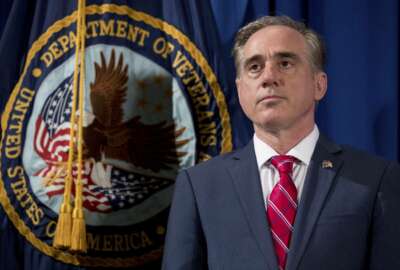

Hubbard Radio Washington DC, LLC. All rights reserved. This website is not intended for users located within the European Economic Area.
According to the Veterans Affairs Department's new reports detailing all major disciplinary actions for its workers, VA is on track to fire fewer people in 2017...
Some federal employee groups and experts are scratching heads over the Veterans Affairs Department’s recent decision to publish a weekly list of all major disciplinary actions for its workers.
VA is the first federal agency to publish such information, and it described the decision as a step toward improving accountability and transparency at a department that has long struggled to use governmentwide disciplinary procedures to tackle entrenched cultural challenges.
“Together with the accountability bill the president signed into law recently, this additional step will continue to shine a light on the actions we’re taking to reform the culture at VA,” Secretary David Shulkin said in a July 7 statement. “Veterans and taxpayers have a right to know what we’re doing to hold our employees accountable and make our personnel actions transparent. Posting this information online for all to see, and updating it weekly, will do just that.”
But federal employee groups and employment attorneys say the department’s new adverse action reports don’t tell the full story about VA’s efforts — or struggles — to improve accountability.
They don’t, for example, explain why VA appears to be on track to fire fewer employees during the first year of the Trump administration than the previous fiscal year.
VA’s July 3 report lists 525 removals during roughly the first six months of 2017. If the department removes employees at the same pace for the remaining six months, about 1,050 employees from VA will be fired by the end of 2017.
Yet according to Office of Personnel Management information on the agency’s data archive FedScope, 2,575 employees at VA were removed for discipline or performance in fiscal 2016.
| VA Removals for Discipline or Performance | ||||||||
| Year | # of Removals | |||||||
| FY2011 | 2,094 | |||||||
| FY2012 | 2,036 | |||||||
| FY2013 | 2,264 | |||||||
| FY2014 | 2,590 | |||||||
| FY2015 | 2,363 | |||||||
| FY2016 | 2,575 | |||||||
Though the recent VA data shows disciplinary actions for the six months of the calendar year and OPM’s information tracks removals for the given fiscal year, the department appears on track to fire fewer employees in fiscal 2017 than it has in each of the past six years.
“They’re firing at about half the rate they did last year,” Richard Loeb, senior policy counsel for the American Federation of Government Employees, said. “I’m not really quite sure what all the claims of accountability are about. Obviously, with the new law, they feel they’ll be able to fire more easily and more quickly. This seems to be a notion of firing your way to excellence.”
The most recent data from VA won’t likely include many removals that the department performed under the new VA Accountability and Whistleblower Protection Act, which President Donald Trump signed into law June 23.
Shulkin has said the new law will allow him to move disciplinary actions through the decision and appeals process more quickly than previous methods. It shortens the time employees have to respond to a disciplinary action, shortens the grievance process, expedites the appeals process at the Merit Systems Protection Board for rank-and-file employees and eliminates the MSPB as avenue for senior executives to appeal disciplinary actions.
In addition, the majority of the adverse actions described in the first report are among lower-level employees at VA, including 94 housekeepers, 55 food service workers and 21 clerks.
Practically all of the 94 housekeepers that were removed or suspended during the first six months of the administration are likely veterans, because a provision in the U.S. Code requires VA hire only candidates with veterans preference to fill certain positions like custodians, guards, elevator operators or messengers.
One person on the July 3 report was listed as a “senior leader” within the Veterans Health Administration’s Central Office, and 17 others are listed as senior leaders within VA medical facilities.
Few other VA employees on the most recent report carry higher-level ranks or senior titles.
One general attorney at VA’s Office of General Counsel was fired in March, for example. A supervisory biomedical engineer and several physicians were also removed.
“The so-called VA scandals allegedly started when senior-level VA officials at the medical centers allegedly created secret waiting lists and the like,” Loeb said. “I doubt that was done too often by housekeepers or laundry workers, but yet that’s where the firing seems to be focused.”
Debra D’Agostino, a federal employment attorney with the Federal Practice Group, said the majority of the employees in these lower-level positions don’t have control over major decisions or policies that dictate how well VA is caring for and treating its veterans.
“This data doesn’t show that there’s any real change happening in VA,” she said.
The adverse action reports don’t list employee names due to privacy reasons, VA said. But the reports also lack details about the specific charges related to each disciplinary action.
D’Agostino called VA’s decision to exclude this information “odd,” but said she and other lawyers within her practice have often argued with federal agencies over these details when seeking information on other employees who have faced similar charges.
Federal circuit case law requires that agencies provide these lists so that employees and their attorneys can compare the charges and decisions with previous disciplinary actions from the department during the appeals process.
“I’m not aware of any private sector employer that routinely fires people, as some do, that publishes a public list,” Loeb said. “[You] might say they’re not public employers either, but there’s no requirement to publish these lists. These are facts, whether people are employed by agencies and how they left the agency, and as necessary, that type of information can be released for some background investigations or employment inquires or the like. But this doesn’t seem to have any utility other than to tell people, ‘Be afraid. Be very afraid.'”
VA’s new public reports list the organization or Veterans Integrated Service Network (VISN) where the disciplinary action occurred, the position that the employee held, the action the department took and the date it was effective.
But they don’t indicate when VA made an initial proposal to remove, demote or suspend an employee for more than 14 days.
“It’s not clear [these] proposals [were] issued before Trump was inaugurated and then the decision was promptly made,” D’Agostino said.
The department can often take six months to a year to decide what kind of disciplinary action to make, D’Agostino added. Though the report only lists actions taken after Inauguration Day, she suspects VA made proposals for some of those actions before the new administration began.
In addition to the new lists, Shulkin will also now require senior officials to approve any monetary settlements with an employee above $5,000. The undersecretary, assistant secretary of an “equivalent senior-level official within the organization” where the dispute occurred will need to sign off on the settlement.
D’Agostino said employee settlements often widely vary.
“$5,000 is a very low bar to require that level of review,” she said. “That’s going to have a tremendous impact on negotiations. Just the fact that it’s been put out there is going to have a chilling effect on settlements.”
Reaching a settlement is the goal, she said, because it acknowledges that the agency and the employee “agree to disagree” and move forward.
“There’s going to be a lot more litigation that gets dragged on and on because of this,” D’Agostino said. “This sends a chilling effect about bringing something like an [equal employment opportunity] EEO claim forward.”
Many federal employee groups said this decision sends the wrong message to the department’s workforce and federal workers in general.
“While there is value in posting these kinds of lists in terms of accountability, the larger and more positive effect, we believe, is to restore public confidence in the federal government’s ability to effectively manage its workforce,” Bill Valdez, president of the Senior Executives Association, said. “There has been a myth floating around that civil servants, because they cannot be fired easily, are unaccountable. This myth, which lists like this prove to be dead wrong, needs to be stamped out because the overwhelming number of federal employees are focused on delivering superior products and services to the American taxpayer. Moreover, the vast majority of civil servants would agree that poor performers should be disciplined or removed from the civil service.”
AFGE, which represents roughly 230,000 VA employees, said it wants to hear more about the department’s plans to fill 49,000 vacancies and improve the quantity and quality of health care to veterans, Loeb said.
“This is not about accountability and it’s not about transparency,” he said. “It’s about sending a message.”
Copyright © 2024 Federal News Network. All rights reserved. This website is not intended for users located within the European Economic Area.
Nicole Ogrysko is a reporter for Federal News Network focusing on the federal workforce and federal pay and benefits.
Follow @nogryskoWFED



